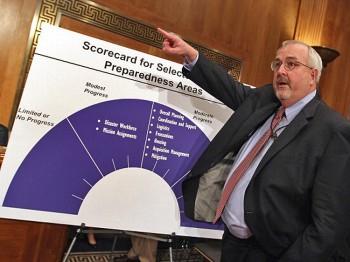BOSTON—In a time of sustained unemployment and foreclosures, it is hard to imagine emergency shelters in a major city folding up beds. But that is exactly what’s happening in Boston. Pine Street Inn, the largest emergency shelter facility in New England, has in recent months removed almost 200 beds for lack of use. Additionally, the national trend for shelter demand has gone down by 24 percent overall.
A new approach called Housing First is being credited with completely turning around the problem of homelessness. That is, chronically homeless persons that seek emergency shelters are no longer required to sober up, take medications and fill out housing forms before becoming eligible for permanent housing. Boston is a prime example of the new method.
As part of a multi-agency effort in Boston, individuals experiencing long-term or repeated episodes of homelessness are being identified through shelters or on the street, are then placed directly into permanent housing equipped with appropriate supportive services.
The Boston Common Ground Housing Initiative for the homeless was first announced by Boston Mayor Thomas Menino in September 2007. Prior to this announcement, several goals that aimed at reducing homelessness were already established under the auspices of another housing strategic plan called Leading the Way I and II.
The first two phases of this comprehensive housing strategic plan were initiated in October 2000; its objective at the time was to relieve pressure on the housing market buildup by the housing bubble, and the attendant sharp rise in sale and rental prices, by meeting the pent-up demand for new housing stock.
During the first two phases of these initiatives, more than 600 vacant public housing units were reclaimed, the vast majority of which went to the homeless. Sixty-three percent of them were for seniors living on the street.
The number of children in homeless families in Boston remained stable at 1,300 from 2000 to 2005, according to the city of Boston. However in 2008 at the height of the foreclosure crisis, the number of these children rose to 2,288 a 70 percent increase since 2005. Reversing the boom in homeless families became a priority in Leading the Way III that aimed precisely at mitigating the worst of the impending housing and credit crisis of 2008 via ambitious preventive tactics.
Boston’s early enactment of preventive measures did limit the subsequent number of foreclosures, thereby preventing additional families from becoming homeless.
The shift of resources from emergency shelters to permanent housing has decreased homelessness across the state of Massachusetts, saving the state money by eliminating emergency room visits and emergency shelters. Nearly $2 million has been saved in Boston alone.
A recent press release from the Boston mayor’s office revealed that Boston’s 31st homeless census showed a 4 percent decrease in the overall homeless census count from 2009.
The number of unsheltered homeless adults counted on the streets decreased by 29 percent (from 255 in 2009 to 182 in 2010—the lowest figure for the unsheltered count since 1997). The number of homeless families sheltered in motels decreased by 45 percent (from 298 in 2009 to 163 in 2010). The number of homeless families decreased by 5 percent (from 1,417 in 2009 to 1,343 in 2010). The number of homeless adults in emergency shelters has increased by 4 percent (from 1,317 in 2009 to 1,365 in 2010).
Boston is working on eliminating long-term homelessness among individuals–from 569 in 2009 to 0, and reducing family homelessness by 50 percent by the end of 2012.
A new approach called Housing First is being credited with completely turning around the problem of homelessness. That is, chronically homeless persons that seek emergency shelters are no longer required to sober up, take medications and fill out housing forms before becoming eligible for permanent housing. Boston is a prime example of the new method.
As part of a multi-agency effort in Boston, individuals experiencing long-term or repeated episodes of homelessness are being identified through shelters or on the street, are then placed directly into permanent housing equipped with appropriate supportive services.
The Boston Common Ground Housing Initiative for the homeless was first announced by Boston Mayor Thomas Menino in September 2007. Prior to this announcement, several goals that aimed at reducing homelessness were already established under the auspices of another housing strategic plan called Leading the Way I and II.
The first two phases of this comprehensive housing strategic plan were initiated in October 2000; its objective at the time was to relieve pressure on the housing market buildup by the housing bubble, and the attendant sharp rise in sale and rental prices, by meeting the pent-up demand for new housing stock.
During the first two phases of these initiatives, more than 600 vacant public housing units were reclaimed, the vast majority of which went to the homeless. Sixty-three percent of them were for seniors living on the street.
The number of children in homeless families in Boston remained stable at 1,300 from 2000 to 2005, according to the city of Boston. However in 2008 at the height of the foreclosure crisis, the number of these children rose to 2,288 a 70 percent increase since 2005. Reversing the boom in homeless families became a priority in Leading the Way III that aimed precisely at mitigating the worst of the impending housing and credit crisis of 2008 via ambitious preventive tactics.
Boston’s early enactment of preventive measures did limit the subsequent number of foreclosures, thereby preventing additional families from becoming homeless.
The shift of resources from emergency shelters to permanent housing has decreased homelessness across the state of Massachusetts, saving the state money by eliminating emergency room visits and emergency shelters. Nearly $2 million has been saved in Boston alone.
A recent press release from the Boston mayor’s office revealed that Boston’s 31st homeless census showed a 4 percent decrease in the overall homeless census count from 2009.
The number of unsheltered homeless adults counted on the streets decreased by 29 percent (from 255 in 2009 to 182 in 2010—the lowest figure for the unsheltered count since 1997). The number of homeless families sheltered in motels decreased by 45 percent (from 298 in 2009 to 163 in 2010). The number of homeless families decreased by 5 percent (from 1,417 in 2009 to 1,343 in 2010). The number of homeless adults in emergency shelters has increased by 4 percent (from 1,317 in 2009 to 1,365 in 2010).
Boston is working on eliminating long-term homelessness among individuals–from 569 in 2009 to 0, and reducing family homelessness by 50 percent by the end of 2012.



Friends Read Free